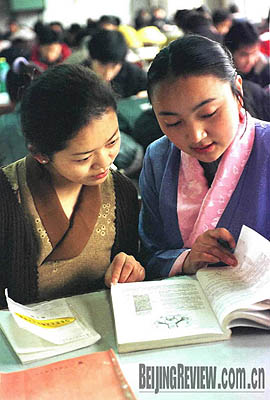
FUTURE LEADERS: Zhenni (left) from Dongga Town in Duilong-Deqing County and Cixi (right) from Bomi County read in the library of the Tibet Nationalities Institute
In 1960, Tenzin, 13, was a poor lama in an ancient temple in the grasslands of north Tibet. That year, he walked for nearly 3,000 km to the Tibet Nationalities Institute, where he enrolled.
His classmates ranged from 12 to late 30s in age, some from poor families, others lamas like himself and others county leaders. Some students had enough education to take university courses, while others were starting from primary school textbooks.
Tenzin couldn't speak Mandarin when he entered the school, but with the help of his teachers he progressed well and graduated, going on to Fudan University in Shanghai where he majored in journalism. On leaving university he worked as a reporter for Tibet Daily, and later became a senior leader of the Tibet Autonomous Region.
"I was a young lama in north Tibet. The Tibet Nationalities Institute was an important stop in my life and was the starting point of my career," Tenzin recalled. "Although I was not a top student in my alma mater, and did not contribute much to her, I have always had a deep feeling for the school, like children feel for their mother."
The Tibet Nationalities Institute was the first school set up by the Chinese Government in Tibet Autonomous Region and its establishment marked the beginning of college education in the region. On October 5, 2008, the school hosted a grand celebration for its 50th anniversary.
Serving Tibet
To train local cadres in Tibet, the Chinese Government officially opened a Tibetan Public School in Xianyang, Shaanxi Province on September 15, 1958, and brought young Tibetan cadres in. On July 1, 1965, the school moved and changed its name to the Tibet Nationalities Institute.
Nearly half of the students of the institute came from Tibet, and went to work in the region after graduation. Many of its 30,000 plus graduates have become leaders at various levels of the Tibetan Government.
Serving Tibet has always been the school's mission. For half a century, it has tailored its education programs to the needs of Tibet. In September 1959, the Tibetan Public School launched its first college-level course in the Tibetan language.
Since 1960, the school has expanded its scope of study to include education, health, agriculture, animal husbandry, veterinarian science, accounting and post and telecommunications. In 1963, the school set up several departments and its courses became more specialized.
